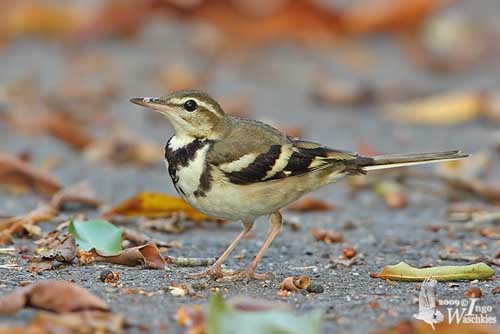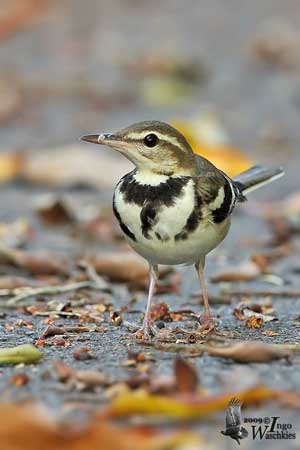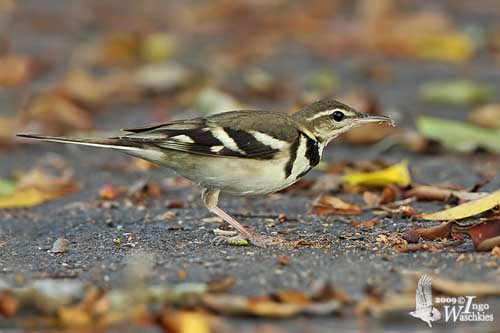
DIET:
The Forest Wagtail feeds on invertebrates such as Hymenoptera, Coleopteran, small grasshoppers, butterflies, cicadas and other insects. It also catches spiders, small molluscs and worms.
It forages on the forest floor and on large branches in trees.
PROTECTION / THREATS / STATUS:
The Forest Wagtail is locally common throughout its range. There is no potential threats identified and the species is evaluated as Least Concern by Birdlife International.
Fr: Bergeronnette de forêt
All : Baumstelze
Esp : Lavandera Forestal
Ital : Ballerina di foresta
Nd: Boomkwikstaart
Sd: Trädärla
Photographer:
Ingo Waschkies
Bird Photography
Text by Nicole Bouglouan
Sources:
HANDBOOK OF THE BIRDS OF THE WORLD Vol 9 - by Josep del Hoyo - Andrew Elliot - David Christie - Lynx Edicions - ISBN: 8487334695
L’ENCYCLOPEDIE MONDIALE DES OISEAUX - Dr Christopher M. Perrins - BORDAS - ISBN: 2040185607
A photographic guide to Birds of Vietnam, Cambodia and Laos by Peter Davidson. New Holland Publishers. ISBN: 9781847731418
A Field Guide to the Birds of South-East Asia by Craig Robson. New Holland Publishers. ISBN: 9781780090498
BirdLife International (BirdLife International)
Wikipedia, the free encyclopaedia
Forest Wagtail
Dendronanthus indicus
Passeriforme Order – Motacillidae Family
BIOMETRICS:
Length: 16-18 cm
Weight: 14-17 g
DESCRIPTION:
The Forest Wagtail is the only member of the genus Dendronanthus. This wagtail differs slightly from Motacilla’s members by different plumage pattern and behaviour. This is a forest species as its name implies.
The adult has brownish-olive crown and upperparts. The upperwing shows a strong contrast between blackish and whitish patterns, forming two conspicuous wingbars. The flight feathers are blackish with whitish edges.
On the uppertail, the central pair of rectrices is brownish-grey washed greenish, whereas the next four pairs are dull blackish-brown. The outer two pairs are whitish with dark bases.
On the underparts, chin and throat are white. We can see a double blackish breast band, but the lower one is often broken. A dark vertical patch is visible in the centre of the breast, forming a T. The rest of underparts are whitish, slightly washed yellow or buffy on flanks.
On the olive-brown head, there is a conspicuous, long, whitish supercilium, and sometimes indistinct dark moustachial and malar stripes.
The bill has dark grey upper mandible and pinkish lower one, occasionally tipped black. The eyes are dark brown. Legs and feet are pale pink. We can see a short and curved hind claw.

Both sexes are similar.
The immature is browner than adults on the upperparts. The breast bands are duller and narrower, and the lower band is often indistinct or absent. The underparts may appear yellowish.
VOICE: SOUNDS BY XENO-CANTO
The Forest Wagtail’s call is a metallic “pink” or “dzinc-dzzt” often uttered in flight.
The song is an intense, disyllabic series of 3-6 notes, often repeated 4-5 times “dzi-chu dzi-chu dzi-chu dzi-chu… ».
HABITAT:
The Forest Wagtail frequents forests both open broadleaved evergreen and deciduous, secondary growth, forest tracks, cultivated areas with trees, mangroves and gardens. It also favours the torrent’s shores.
This species can be seen up to 1500-1800 metres of elevation.
During winter, it is found in wooded cultivation and plantations, clearings and mangroves. It may forage in mudflats and pastures during migration and winter.
RANGE:
The Forest Wagtail breeds in SE Siberia, Ussuriland, Sakhalin, SE China, N and S Korea and S Japan.
This species winters in India, Bangladesh, S China, Greater Sundas and Philippines.
BEHAVIOUR:
The Forest Wagtail forages mainly on the ground where it can find small invertebrates, insects, spiders, molluscs and worms. It runs about on paths in the shady parts of the forest or on the leaf-litter on the forest floor. But it also forages in trees, running along horizontal branches and picking at prey items while walking or running on low branches or on the ground. It may perform flycatching from high perch.

The Forest Wagtail is usually seen alone or in pairs. If disturbed, it flies to a perch in tree and then, it sways tail and body from side to side. This is another difference compared to other wagtails which usually move the tail up and down.
In some areas, the birds roost communally and sometimes in large flocks.
During the breeding season, the Forest Wagtail performs aggressive territorial flights, but also spectacular flight displays.
It rises in the air from the ground or a perch, between 8 and 12 metres above the ground, and then, it flies down while uttering series of high-pitched calls, the metallic “pink” or “pink-pink”.
Both sexes defend strongly the territory during the nesting period. They are monogamous.
This species is migratory (see Range) and usually leaves the breeding areas in late August.
FLIGHT:
The Forest Wagtail is agile in flight, and especially during the deep undulating flight displays.
REPRODUCTION:
The breeding season occurs mainly in April-June.
The Forest Wagtail nests in trees and the nest is placed on horizontal branch, often close to the trunk, between 2 and 7 metres above the ground and usually near a stream.
The nest is built by the female, accompanied by the male. This is a compact cup made with twigs, leaves, fine grass and rootlets, held together with spider webs and moss. The outer part of the nest is covered with lichens, making it almost invisible. The inner part is lined with softer materials such as hair, wool and moss.
The female lays 4-5 eggs and incubates alone during 13-15 days. The male feeds her during this period. The chicks are fed by both parents, and fledge about 10-12 days after hatching.
